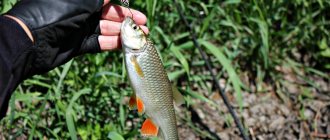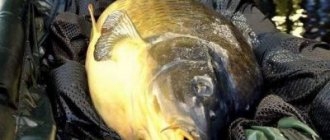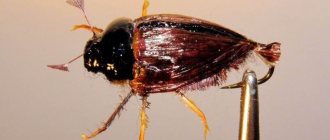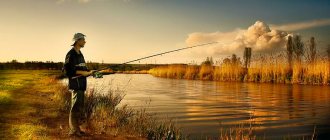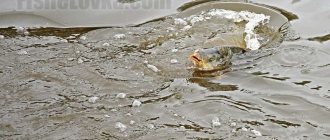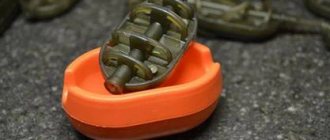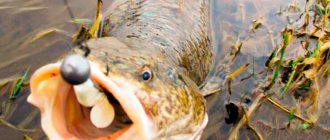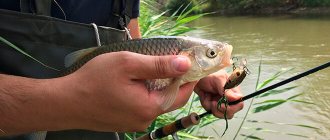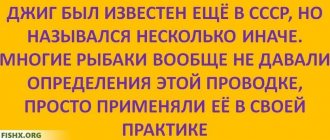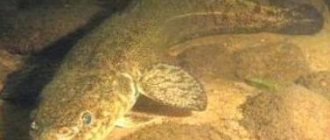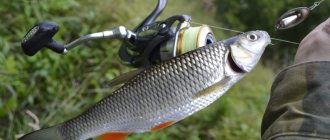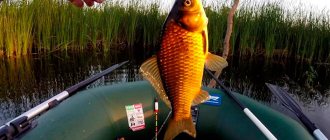There are many ways to catch chub. To hunt for this fish, float rods and donks, spinning and fly fishing, and bombard rods are used. Chub can also be caught by trolling. The fishermen’s arsenal includes natural plant and animal baits, any variants of spinning baits and fly fishing flies. Among this variety, bread stands out. This is the simplest bait that costs almost nothing; the most basic gear is enough for fishing with it - and you can still get excellent catches.
Features of the nozzle, advantages and disadvantages
Chub are usually caught for bread near the surface in the summer. Summer is the best time for such fishing, as the fish are active and at the same time they are well attracted to plant foods.
The main method of fishing is to float the bait along the surface so that it is carried away by the flow of water. In this way, bread placed on a hook can be melted over several tens of meters. In reservoirs with stagnant water, chub are usually not caught with this bait.
The main advantages of bread or loaf as an attachment:
- accessibility - it is easy to buy, and you can find it on sale anywhere, from a big city to a small village, it is inexpensive;
- convenience - you just need to cut the purchased loaf into cubes, after which the attachment is ready for use - thus, there is a minimum of hassle;
- catchability - thanks to its aroma, bread perfectly attracts chub, this bait brings good catches in open water, and can also be successfully used in winter chub fishing;
- This is a suitable bait for trophy fishing , as large chub respond to it very well.
There are no disadvantages to bread as bait. The only thing that can be considered a disadvantage is that it will not bring chub catches in all situations.
For example - as already mentioned, it is not best suited for stagnant bodies of water. But no other bait will be absolutely universal.
What to fish with
The chub is omnivorous, so you can catch it both with baits of animal origin and with all kinds of plant baits. At the same time, there is a fairly pronounced seasonality in the choice of bait. She is jealous of the chub's food supply at the moment.
In early spring , before the flight of the cockchafer, good results are shown by baits of animal origin , mainly from:
- worm;
- maggot;
- grasshopper;
- locusts;
- bloodworm;
- small fish;
- pearl barley meat.
Fishing for chub in May, late spring and early summer sometimes brings good results when baited with a regular bread crust .
Closer to summer catching a chub with a cockchafer becomes the best choice for catching a big-headed chub, since it may refuse other types of bait completely.
In summer the big-headed fish pecks at insects and loves caterpillars and grasshoppers . In autumn, bottom gear with a feeder is better suited. During this period, large specimens peck at young frogs .
In some bodies of water it shows interest in cheese cut into small pieces. Fishing for chub on large and small rivers is effective using chicken liver .
Choosing fishing gear
For catching chub on bread, a fishing rod with guide rings is best suited. This could be a specialized tackle for line fishing - a lapdog - or a match rod.
Even a spinning rod 2-3 meters long will do, although fishing with it will not be as convenient.
The fishing rod must be equipped with a spinning reel; suitable sizes are from 1500 to 3000 depending on the size of the fish. With the inertia-free action you can confidently cast light rigs.
Monofilament, braid, and fluorcarbon are suitable as the main fishing line. Braided cord is good because it does not stretch and provides high sensitivity of the tackle and confident hooking at any distance.
The advantage of fluorocarbon is that it is minimally noticeable in the water, which is very important when fishing for chub near the surface. Monofilament is the simplest and cheapest option.
If monofilament or fluorocarbon is used as the main line, it is better not to use leaders. Without unnecessary knots, the rig will minimally alarm the fish. If the main line is braided, a transparent leader will be a plus.
A float and sinker are usually not used. These elements are not needed when fishing with bread from the surface. They will only scare away the chub. Hooks can be used from 5 to 10 numbers according to the Russian classification. The larger the chub and, accordingly, the bait, the larger the hook should be.
Fishing for bread and bread crumbs
The advantage of bread crumb is that this attachment is generally available, and the balls from it stick very well on the hook. True, it is rarely used in its pure form: fish sometimes treat this bait quite coolly, preferring various cereals, peas, and corn grains. However, the bite on bread can be significantly improved if you use suitable additives.
Adding Unifeed
Adding ordinary fishing food to the bread crumb enhances its attractiveness. The bait itself, however, does not hold well on the hook, becoming looser, so it is better to give the crumb the shape of a drop.
For this combination they take crucian carp, carp, ide, chub, large roach, bream, silver bream, dace and other white fish.
Bread crust for bream
But it’s better to catch bream not with crumbs, but with a piece of crusty bread. Before fishing, pieces of bread are fried in a frying pan, and then square pieces are cut out of them so that the crumb is adjacent to the crust. It allows the bait to stay on the hook more firmly, and its decent size (1x1x1 cm) prevents small things from knocking the bait down, although there will certainly be attempts to do so.
Carp and carp can easily be used for bread crust. In this case, an even larger piece (with a side of about 1.5 cm) is hung on a hook than when fishing for bream.
"A cheese sandwich
To catch chub, you can mix bread crumb and grated cheese (Kostroma, cheddar, Edam) in equal proportions. The best method of fishing with such a bait is a running donka.
Read! Catching grass carp on reeds
Bread with garlic for crucian carp
Adding a very small amount of garlic to the bread crumb (literally at your fingertips) will attract crucian carp to your baits. And if you add a “garlic” additive to your bait or bait, then it is quite possible to interest all the crucian carp living in the pond.
For those with a sweet tooth
Mixing crumbs from honey gingerbread or “black” gingerbread into the crumb increases the likelihood of bites from crucian carp, as well as carp and carp. These fish have a “sweet tooth” and are partial to honey. However, try not to abuse its quantity. A bait that is too sweet will scare rather than attract fish.
Store-bought flavors
To enhance the bite, you can mix various flavors into the bread: vanilla, dill, strawberry, banana and others, which are offered to fans by fishing stores. Before use, carefully read the instructions: how much aromatic mixture should be added, what time of year it works, what fish it is intended for.
When using fragrances, remember that they only work well for one day. If you plan to fish for several days, then the bait must be prepared every day.
Vegetable oils
Garlic, hemp, flaxseed, unrefined sunflower, and, of course, anise oils added to bread crumb have been used by fishermen since ancient times. Since then, little has changed: just like in the old days, adding a small amount of these oils to bread provokes fish to bite more actively.
With porridge
An excellent attachment is obtained by mixing bread crumb with millet or oatmeal porridge in a 1:1 ratio. The crumb makes the bait more viscous, and it stays on the hook better. Millet is one of the most attractive baits for carp, crucian carp and bream. A mixture of bread and oatmeal porridge will attract carp to the bait. However, the bream can ignore this bait.
Read! Mastyrka for fishing
Crust or crumb?
They also catch fish such as chub and ide on bread. Moreover, fishermen often argue about how best to catch these fish: with a crust of bread on top or with crumbs in the water column. In my experience, both methods are effective. Only you need to use them at different times of the year. In spring and autumn, it’s better to fish with bread at the bottom, and the bite on top is more likely in the summer.
Bread with potatoes
A bait consisting of equal parts of rye bread and mashed potatoes is practically a win-win when fishing for carp and carp. Especially if you flavor it a little with unrefined sunflower oil.
With animal bait
Bread crumb is used, as well as dough when fishing with “sandwiches”. The dough in combination with maggots, bloodworms or a piece of worm evokes the appetite of the same white fish.
True, you need to make “sandwiches” in different ways. In the “maggot-crumb” combination, the maggot is placed on the hook first, and the tip of the hook is covered with bread.
If you are fishing with the “crumb-bloodworm” or “crumb-worm” combination, first hang bread on the hook, and then cover the tip with animal bait.
Some fishermen, for example, do not bother with baiting two different baits, but simply mix crumpled fish into the bread.
Which bread to choose for attachment
To catch chub, you can use both white and black bread. But the latter is preferable, since its aroma is stronger.
It is best to cut the bread into cubes. This is the simplest option and works great. The length of the edge of such a cube can be from 1 to 2 cm, depending on the size of the chub.
Once the bread is sliced, it can be placed on the hook. Additionally, there is no need to dry it at room temperature, in the oven or in the microwave. Also, no flavorings or dips are needed for bait. Bread, especially black bread, has a rather strong attractive smell. This aroma spreads far in the water and attracts chub even from great distances.
When to catch chub with bread
The season for active fishing for lobster fish begins in June. At this time the fish bite very well. In July, fishing continues, but there is usually a dip in activity.
In August, the heat subsides, and the chub begins to prepare for the winter and becomes active again.
When fishing for chub in winter with bread as bait, it is better to attach bait of animal origin, such as bloodworms, maggots or worms, to the hook.
Animal food is known to attract fish best in winter. The colder the water, the less relevant plant baits become. Reference. In winter, bread can be used as bait when fishing for chub. For this, a feeder feeder in the form of a cylinder with small holes is best suited. The bread will be washed out of it gradually, in small portions. Thus, the bait will work perfectly.
Catching chub with bread: necessary gear, choosing a place and tactics for fishing
There are many ways to catch chub. To hunt for this fish, float rods and donks, spinning and fly fishing, and bombard rods are used. Chub can also be caught by trolling. The fishermen’s arsenal includes natural plant and animal baits, any variants of spinning baits and fly fishing flies. Among this variety, bread stands out. This is the simplest bait that costs almost nothing; the most basic gear is enough for fishing with it - and you can still get excellent catches.
Choosing a fishing spot
You need to catch chub for bread at points where it is easiest for him to find food. On rivers, such areas can often be seen even with the naked eye, simply by approaching the water:
- The most promising areas are the boundaries of direct and reverse flows, fast and slow flows, currents and standing water. Here the fish always have the opportunity to take a break from fighting the stream and find food. It is better to present the bait so that it floats downstream and ends up in a backflow or standing water.
- Areas above and below the rifts and the rifts themselves also traditionally attract chub. It is better to carry out the wiring so that the bait passes throughout this entire zone - both in front of the threshold, and along it, and below.
- Under the steep banks and trees overhanging the water, the chub waits for insects that have fallen into the water. But he will not refuse bread that floats downstream.
- This fish lives on various bottom anomalies - edges, holes, snags. The chub easily rises from the bottom after the bait moving along the surface, if it is attractive enough for him.
Reference. It is convenient to catch chub for bread from capes that protrude into the river. Standing on such a ledge, you can release the bait very far along the stream, and any fishing rod will do for this.
Scheme for catching chub with a spinning rod on a bread crust
Bread fishing tactics
In conclusion, I’ll tell you about some features when fishing with bread and bread baits.
Only near residential areas
Firstly, it’s worth mentioning right away that in reservoirs that are rarely visited by fishing enthusiasts, fishing for bread is unpromising, and sometimes even simply useless. Fish in these places (oxbow rivers remote from habitation, forest lakes, silted ponds) simply ignore bread baits, clearly preferring bait from their daily diet - bloodworms, worms or insects falling into the water.
Read! Pearl barley bait for fishing
The most likely places where carp will bite well on bread are places where this bait is familiar to the fish: ponds, lakes and rivers located or flowing near residential areas.
Suitable places for fishing with bread
The interest of underwater inhabitants in bread can vary even within the same body of water. Basically it all depends on the place where you offer this bait to the fish. For example, an excellent bite on a piece of bread crumb is possible near bridges on rivers or dams, on ponds where, due to circumstances, bread often falls into the water.
They will also peck at bread in the area of bathing areas, in places where they rinse clothes (for example, bridges within populated areas), and on river currents near banks with a clean bottom.
Where is it better not to fish for bread?
But in silted bays or rivers with weak currents and a coastal strip heavily overgrown with algae, fishing for bread is not very effective. Bites on bread baits are also bad in fast currents: here the fish simply does not have time to eat the piece of bread offered to it.
At the bottom
The bottom for fishing for bread should have a hard clay, clay-sand or even silt-sand coating. There shouldn't be a lot of sludge. It bites better in a weak or moderately weak current on a bait slowly dragging along the bottom.
Often they fish in rivers simply from the bottom, equipping the tackle with enough weight to hold the bait on the ground.
It is worth recalling that bread is a nozzle for warm water. If the water in the reservoir is cold (below 14 degrees), then instead of bread it is better to offer the carp other baits and attachments.
Impaling
To put bread on a hook, you need to insert the sting inside and then move it further. As a result, the bait should be securely mounted. You want the point to remain inside the bread cube.
You don’t have to worry that the chub won’t be caught well because the sting doesn’t stick out. Bread soaks in water and becomes soft quite quickly. On the one hand, this does not prevent him from staying on the hook quite well. On the other hand, soggy bread itself is not an obstacle to good hooking.
This video shows several ways to attach bread to a hook:
Fishing technique and tactics
The best option for catching chub with bread is sea fishing. You need to move around the reservoir from one interesting point to another and consistently catch them. You can also fish stationary - sit in one place and perform long retrieves, releasing the equipment 40-50 m or more .
Bait is not needed for this type of fishing. The chub is attracted to the fishing zone by bread placed on a hook, which gradually crumbles. He lures the little things, and they begin to fuss around the hook. The chub also approaches the bait behind it. But you can also feed the fishing zone with the same bread, throwing it into the water so that it floats downstream.
Reference. If the chub does not want to peck, you should periodically, once every 1-2 minutes, stretch while moving downstream. Using this simple technique, you can highlight the bait on the surface of the water and attract fish to it.
The bite is clearly visible by the splash that usually occurs when the chub takes bread from the surface. It is also transmitted along the fishing line to the hand. After the chub has taken the bait, it is best to give it another 1-1.5 meters of fishing line, and then hook it and start fishing.
Catching chub on a crust. Practical advice on making tackle and bait
There are many fishermen who like to catch fish such as chub. Those fishermen who are just beginning to take their first steps towards catching this fish do not always achieve good results. The fact is that the chub, a very cunning and cautious fish, and suspecting something is wrong, can swim next to the offered bait and not pay attention to it. It is especially difficult to catch an already large, seasoned chub, which is very rarely caught, even by experienced fishermen. But there are many ways and clever equipment with which you can cope with this task.
One of the methods by which chub is caught in open water in the summer has existed for a very long time, but to this day it has not lost its attractiveness. For successful fishing, you will need a spinning rod with a reel, with at least seventy meters of fishing line wound. It is best to take a reel without inertia, and a fishing line with a diameter no thicker than zero two millimeters in diameter. A hook with a long shank from number six to number eight is attached to the fishing line. For the attachment, take the crust of dark, already stale bread and cut into squares measuring two by two centimeters. We will attach the crust so that the hook does not frighten the cautious and already timid fish. Having pierced our crust square near the middle, we pull out the hook to the other side of the square so that it comes out from its soft side. Having taken out the hook from the soft side, we hide the tip of the hook, driving it into the loose bread pulp. The result is a rig that has nothing but a fishing line and a hook, which we cast as far from the shore as possible.
Read: Perch fishing techniques, tackle, lures and bait
The abandoned bait, made from a crust of bread, remains floating on the surface of the water and you need to wait for it to be carried away by the current. The chub will become interested in her when she swims a decent distance. Visually observing the floating crust, we will see how the fish swallows our bait, it will disappear from the surface of the water. After the bait disappears, the line will stretch slightly and may move to the side, at this moment a sharp hook is made. For effective fishing, before throwing the bait, you need to decide on the fishing location in the reservoir. The place is chosen with the expectation of convenient casting and good visibility of observing the floating bait. But the most important thing is to make sure that the chub is present in this place. In summer, it is very easy to spot a chub in a pond; it swims close to the surface and makes splashes, hunting for insects.
For this fishing, light floating bait is used, which may include bread crumbs, crushed cookies, bran, but the most effective is ground fried seeds. The bait is thrown into the water in dry form, it immediately wakes you up at the fishing site, and the activation of small fish is noticeable, along with which chubs will also approach. To catch large chub, pieces of bread are cut a little larger so that smaller individuals cannot swallow them. Also, the crust on the hard side can be greased with honey, this will double the chance of catching a big fish.
